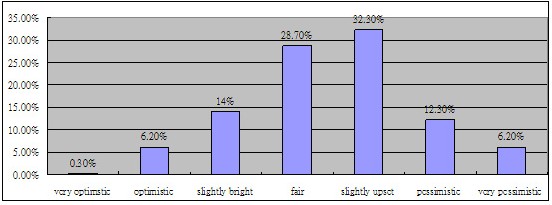Taiwanese optoelectronics manufacturers from LED, photovoltaic, LCD, and opto-communications sectors, revealed relatively weak confidence in the industry’s outlook for Q4, according to a survey conducted by Photonics Industry Technology and Development Association (PIDA).
The survey questionnaire asked respondents to choose from among seven degrees of confidence: very optimistic (a score of 100), optimistic (85), slightly bright (66), fair (50), slightly upset (33), pessimistic (16), and very pessimistic (0). There are 341 Taiwanese optoelectronics manufacturers joining the survey. The median score, on a scale of 0-100, was 42, down from 47 in Q3.

Source: PIDA
Of the 341 respondents, 0.30% felt very optimistic, 6.20% felt optimistic, 14% felt slightly bright, 28.70% felt fair, 32.30% felt slightly upset, 12.30% felt pessimistic, and 6.20% felt very pessimistic.
PIDA project manager Murphy Lin says that the results of the survey suggest that the island’s optoelectronics manufacturers are becoming guarded about the direction in which their industry is going. “This survey reflects the rather low confidence of the industry in Taiwan,” Lin comments. “It’s not good news, but there are still promising developments in each sector.”
For the LED sector, streetlights offer a good market. The state-run Taiwan Power Corp. recently cancelled a subsidy it had given to city agencies to help pay electrical bills for streetlights, after the central government announced that another planned hike in electricity fees would be delayed because the previous hike had alleviated the losses suffered by the company due to a long-term price freeze. The cancellation is expected to accelerate the move by city agencies to install LED streetlights.
This will encourage local LED manufacturers to compete for public works projects. Since industrial standards for LED lighting have not yet been finalized, the PIDA urges local governments to carry out strict inspection of LED streetlights to ensure quality.
Another happy development is that LED-lighting suppliers are making their products more affordable, and are making them available both at brick and mortar stores and on the Internet.
However, consumers have been left confused by the inconsistency of specifications defined by suppliers of 6-12W cool white LED bulbs used as 40-60W incandescent replacements. For instance, LED bulbs designed to replace 60W incandescent bulbs have been labeled by different suppliers with incandescent lumen ratings ranging from 420 to 810.
Insiders emphasize that government regulators should provide clear and consistent LED bulb lumen specifications that precisely match incandescent lumen specifications so that shoddy products will not be able to push quality products out of market.
The PIDA suggests that in addition to providing labels with clear product specifications, manufacturers need to introduce LED bulbs that are much better, in terms of energy efficiency, than CFLs equipped with efficient ballasts.
The association feels that purchases of LED bulbs will likely increase if the government includes the bulbs in a labeling system established by the government to rate electrical products according to energy-saving performance.
Source : www.cens.com












